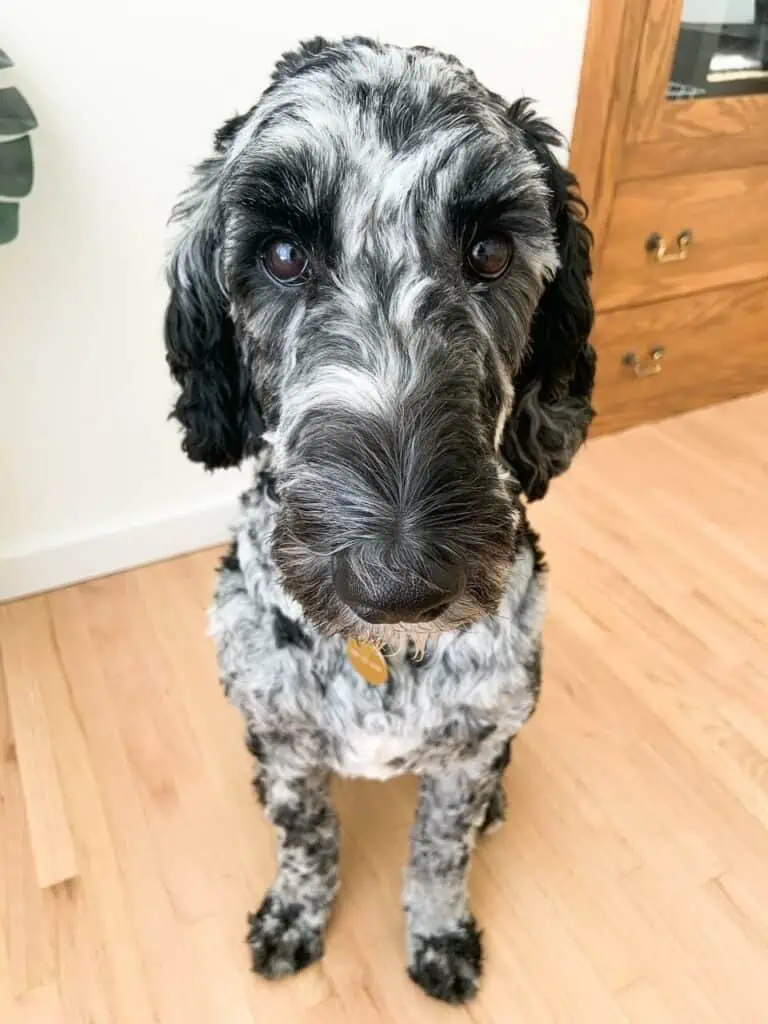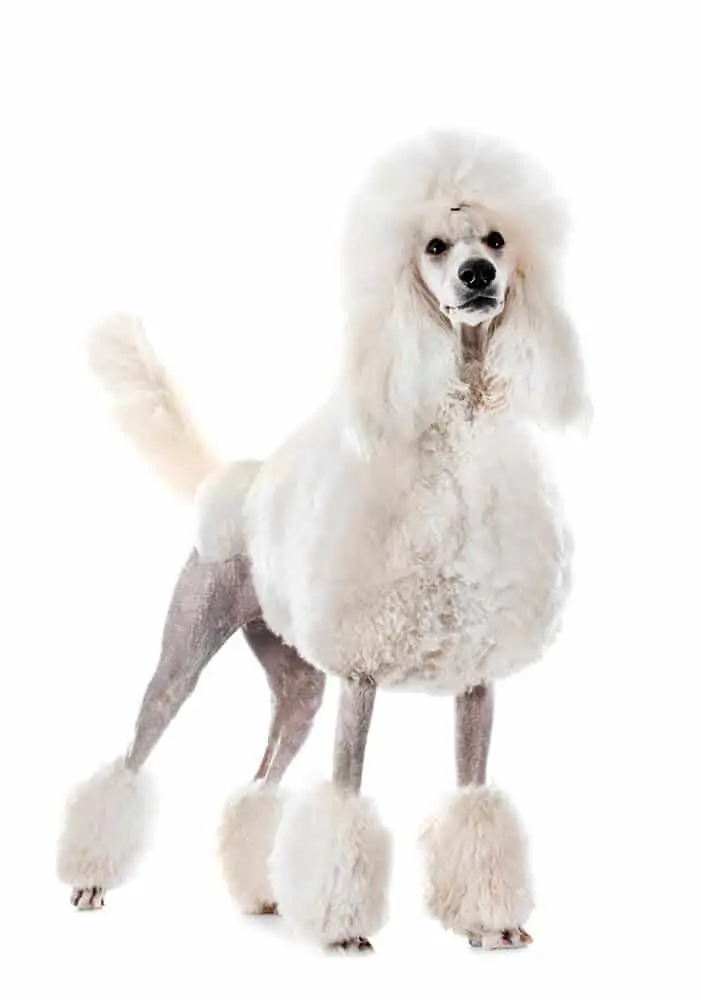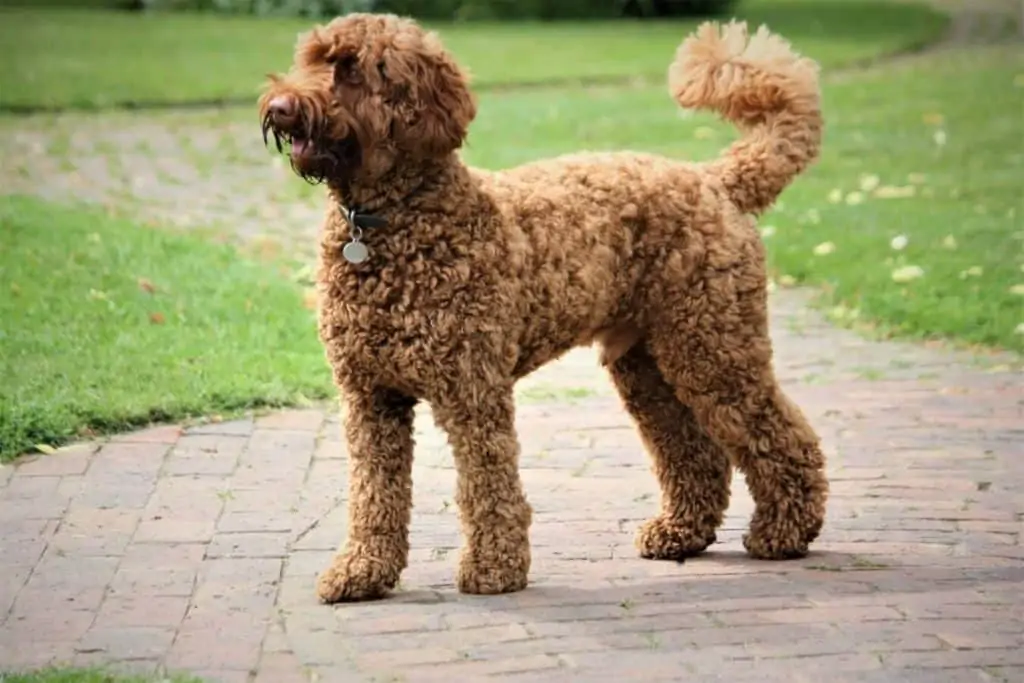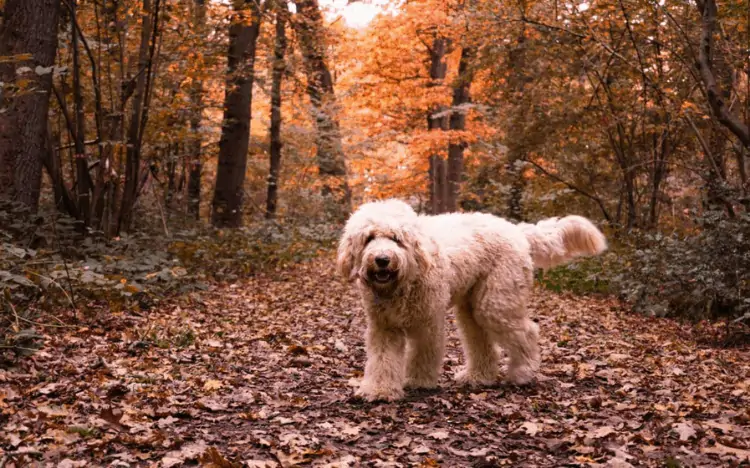Last Updated on
I recently adopted a Labradoodle, and I can see why so many people are interested in this sweet breed.
With their oh-so-cute looks and fun-loving personalities (not to mention their low-shedding coats), it’s no wonder people are falling head over heels for these mixed-breed pups.
Whether you’re a newbie dog owner or a seasoned pro, the Labradoodle is a breed that’s worth checking out.
In this article, we’ll get up close and personal with the Labradoodle and spill all the details you need to know before bringing one home.
I’ll even tell you why I don’t think you should get a Labradoodle…
Ready to know more? Let’s dive in.
| Labradoodle Quick Facts | |
| Weight | 40 to 75 pounds |
| Height | 22 to 24 inches tall |
| Temperament | Energetic, intelligent, outgoing, protective |
| Lifespan | 12 to 14 years |
What Is A Labradoodle?

A Labradoodle is a cross between a Labrador Retriever and the Standard, Miniature, or Toy Poodle.
The result? An adorable and loveable pooch, also known as the Labradoodle (or Labrapoo, Labradoo, Labradorpoodle, or Labradorpoo).

Many people wonder if an Australian Labradoodle is the same as a Standard Labradoodle, and the answer is no. Australian Labradoodles are a mix of six different dog breeds, whereas Standard Labradoodles are just two: the Labrador and the Poodle.
Labradoodle Appearance

Like most Poodle-mix dogs, Labradoodles have floppy ears. Being part Labrador Retriever, Labradoodles tend to have thick tails that serve as “rudders” while swimming. Their tails help them navigate through the water and turn with ease.
Labradoodles can have a variety of nose colors, which vary depending on the dog’s coat color and genetics. Here are some of the most common nose colors for Labradoodles:
- Black: This is the most common nose color for Labradoodles, especially for those with black or darker coat colors.
- Liver or brown: Some Labradoodles may have liver or brown-colored noses, particularly those with chocolate or red coats.
- Pink: In rare cases, some Labradoodles may have pink or partially pink noses, which is often due to a lack of pigmentation in the nose.
- Dudley: This is a term used to describe a Labradoodle with a nose that is the same color as its coat, giving the appearance of a “flesh-colored” or “lack of pigment” nose.
Let’s dive into the different coat types, colors, and sizes of Labradoodles.
Coats

While Poodles have a non-shedding and hypoallergenic coat, Labradors tend to shed hair, not fur. When you breed these two, it’s likely you may still be allergic to your dog, however, most Labradoodles are considered hypoallergenic dogs.
That being said, a Labradoodle puppy can have three different fur coats depending on the genes transferred:
- Straight coat: This coat sheds a lot and is pretty rare. Breeders avoid dogs with straight hair as most people want Labradoodles that don’t shed.
- Fleece coat: This coat is also called wavy hair. It sheds very little to nothing at all.
- Curly coat: Curly coats are dense, thick, tight, and curly—think of the coat of a Standard Poodle!
If the hair type matters to you, we recommend speaking with different breeders to see what they have to say and which types of dogs they will be breeding. Keep in mind that breeders cannot predict the coat of their litters with 100% accuracy.
Colors
Labradoodles come in a fantastic array of colors, including red, apricot, black, dark chocolate, blue (which is rare), silver (also rare), golden, and white. Depending on the texture and color combinations, Labradoodles can be classified as Parti, Sabre, or Merle Labradoodles.
Parti Labradoodle Dog
Parti Labradoodles are a unique and eye-catching. These dogs are considered rare because the multicolored pattern is a recessive trait in Poodles.
Breeding for this trait requires careful consideration and DNA testing to identify the recessive genes in both parents. Typically, parti Labradoodles have a distinctive color combination of white (which is always present) along with apricot, red, black, silver, or blue.
Sable Labradoodle Dog
The easiest way to describe sable is coat is by comparing it to ombre hair, where the hair is darker near the shaft and lightens near the tip. German Shepherds are well-known dogs with sable coats, but you can also find Labradoodles with sable coats.
Sable Labradoodles can come in a range of colors, including black, brown, cream, and red, and can be found in different coat types, such as curly, wavy, or straight.
Merle Labradoodle Dog

A merle dog coat is a coat pattern found in some dog breeds that creates a mottled or speckled effect of darker patches and lighter spots. The word “merle” refers to the pattern, not a specific color. For example, the dog above is a black Labradoodle with a merle coat. The merle coat makes him look like he’s grey and white, but he is, in fact, black!
The merle pattern is created by a gene that regulates pigment distribution in the dog’s coat. Merle is common in breeds such as Australian Shepherds, Border Collies, and Catahoula Leopard Dogs, but can also be found in Poodles. But there’s a catch: Poodles with the merle gene are not purebred Poodles. Merle isn’t a gene naturally found within Poodles, so if you have a merle Poodle, it has been crossed with something else somewhere in its lineage.
That being said, it’s rare to find merle Labradoodle, but they do exist. (I adopted a merle Labradoodle and he has a striking coat.)
Keep in mind that the merle gene can be quite dangerous: breeding two dogs with the merle gene can result in double merle puppies. Double merle genes can result in deformities, blindness, and other medical issues.
If you want a merle Doodle-dog, consider the Aussiedoodle, who has an Australian Shepherd as a parent and is more likely to have merle coats.
Size
Labradoodles come in different sizes depending on whether they’re mixed with a Mini, Standard, or Toy Poodle.
Miniature Labradoodles are around 14-16 inches tall and weigh 15-25 pounds. As for the difference between a Toy Labradoodle and a Mini Labradoodle, it’s not much: A Toy Labradoodle is about 14-15 inches tall and weighs between 13 and 20 pounds.
On the other hand, Standard Labradoodles are typically 22-24 inches tall and weigh between 40 and 75 pounds.
Labradoodle Temperament and Characteristics

Labradoodles are brilliant dogs that inherit traits from their two breeds. However, how your dog turns out depends on things like the environment they grow up in, their parents, the people around them, the breeder, and how much socialization and training they get.
Before we dive into the unique characteristics of Labradoodles, let’s get to know their two parent breeds: the Poodle and the Labrador Retriever.
Poodle

Poodles may have gorgeous curly hair and stunning looks, but don’t let their appearance fool you – they are actually hunting dogs that excel at water retrieving! They are famously smart and excel in all kinds of sports. On top of that, Poodles are also top-notch watchdogs, police dogs, and even guide dogs.
Overall, they are sweet, fun-loving, caring, and intelligent.
Short Summary of a Poodle’s Characteristics:
- Very playful and active
- Alert and instinctual
- Trainable
- Needs company and close attention
- Wary to new people
Labrador Retriever

Labrador Retrievers
No matter how big they grow, Labradors always keep their puppy-spirit. These naturally cheerful, outgoing, and fun-loving dogs are big extroverts who love meeting new people and animals—including cats! They’re great at hunting and make excellent guide dogs and service dogs.
But don’t let their enthusiasm fool you: Labs don’t do well with boredom. If left alone, they might resort to troublemaking, like chewing up your furniture or shoes. Be ready for lots of exercise and adventures with your furry partner—your Lab won’t let you sit still.
Short Summary of a Labrador’s Characteristics:
- Great with people, babies, and other animals
- Will give you great exercise every day (and probably exhaust you!)
- Loyal
- Big eaters. Make sure you are not feeding them too much or too little
- They love humans
- Trainable and sociable at a young age
Labradoodle’s Temperament

The Labradoodle temperament is a combination of both the Labrador Retriever and Poodle, which means that there are many possible variations in personality, energy levels, and traits. Despite this, Labradoodles are generally known for being highly intelligent, sociable, and playful dogs.
Overall, the Labradoodle is an amazing breed that combines the best traits of both Poodles and Labrador Retrievers. They are friendly, outgoing, intelligent, and highly trainable. They make great family pets and companions for active families who love to spend time outdoors.
Let’s dive into each trait:
Outgoing
Labradoodles are very outgoing and love to be around people. They are sociable, friendly, and happy dogs. This temperament comes mainly from their Labrador Retriever side. They enjoy being part of the family and will follow you around wherever you go.
Protective
Both Poodles and Labradors are known to be excellent family dogs that love and protect their families. Labradoodles have inherited this trait from both of their parent breeds. They are very loyal to their families and will do anything to protect them. You can rest assured that your Labradoodle will be a loyal and protective companion.
Playful
Labradoodles have a playful temperament and enjoy lots of physical activities. This trait is inherited from both the Poodle and Labrador Retriever breeds. They love to play with their family, especially children. They enjoy running around and playing fetch, so get ready for some heavy exercise sessions.
Energetic
Both Poodles and Labradors are highly energetic dogs and require a lot of activities to keep them stimulated. Labradoodles are no exception, and they need a lot of exercise and playtime to stay healthy and happy. This breed enjoys activities such as running, hiking, swimming, and playing fetch. They make great companions for active families.
Sociable
Labradoodles are social dogs and enjoy being around other people, animals, and babies. They are very friendly and outgoing, and they love to make new friends. They are great with children and other pets, and they are always up for making new friends.
Intelligent
Labradoodles are a very intelligent breed that enjoys learning and performing tasks. They love to work and play, and they are highly trainable. This temperament comes from both the Poodle and Labrador Retriever breeds. They are great at obedience training, and they can learn to do many tricks and tasks. Training is essential to keep them mentally stimulated and to prevent them from becoming bored and destructive.
Exercise Requirements
If you’re looking for a laidback dog, the Labradoodle is not for you! Labradoodles are highly active—if they don’t get enough daily exercise, they can become destructive.
Labradoodles require two hours of exercise every day, like walks, runs, or fetch. You can also get a dog treadmill to use indoors if you’d like to exercise your Labradoodle inside on days when the weather isn’t safe for your dog to go outside (think too smoky, too hot, too cold, etc.).
Other options for exercising your Labradoodle include doggy daycare and hiring a dog walker to help you on days you can’t take your dog out.
Training a Labradoodle
Labradoodles are relatively easy to train, but like all dogs, Labradoodles require patience, consistency, and positive reinforcement.
Positive reinforcement is a training method that involves rewarding desired behaviors. This method has proven to be effective in teaching dogs new skills and behaviors.
Positive reinforcement training should always be a fun and positive experience for your dog. Use an upbeat tone of voice and give plenty of praise and affection when your dog responds well to a command or behavior.
Labradoodles tend to be highly food-driven, so you can use treats and even dog food during training sessions. However, if your Labradoodle isn’t food motivated (my Sheepadoodle isn’t food-motivated) try using playtime, toys, and physical affection as rewards.
Relate: I put together a list of the best toys for Labradoodles to help you find ones your pup will love.
Space Needed For A Labradoodle
I generally believe all dogs can thrive in both big and small homes, so long as they get the exercise and mental stimulation they need.
However, Labradoodles love playing fetch (not all, but a lot will—each dog is different). I notice that if we don’t play fetch with our Labradoodle, he tends to get hyper, even if we take him out for 2-3 hours of walks in a day—he needs that fetch time! After all, it’s hard-wired into his brain to retrieve.
Luckily, we have a backyard that is long enough to throw a ball. If you don’t have a backyard where you can play fetch with your Labradoodle, try to find other safe (and enclosed) areas where you might be able to play fetch throughout the week.
You can also teach your Labradoodle to retrieve items for you at home, so they can still use their retrieval instincts without needing lots of space to run after a ball.
Grooming a Labradoodle
Labradoodles need plenty of grooming. Their coats are often long and curly (unless you shave them down), and they can mat easily and quickly.
To avoid matting, you need to brush your Labradoodle’s hair daily or every other day. If not, mats can form.
To make grooming sessions as comfortable as possible, brush and comb your Labradoodle as soon as you get them as a pup. Be sure to reward them with treats and praise for positive behavior during the grooming process.
In addition to daily grooming, it’s also crucial to schedule regular grooming appointments with a professional groomer. During these appointments, your Labradoodle may receive haircuts, shampooing, nail trimming, ear cleaning, anal gland expression, and teeth brushing.
By grooming your Labradoodle regularly, you not only keep their coat healthy and clean but also strengthen the bond between you and your dog. A well-groomed Labradoodle is a happy and healthy one!
Here are a few tips for grooming your Labradoodle at home:
- Apply detangling spray.
- Brush your dog’s hair and use a de-matting rake to remove any mats.
- After mats and tangles are removed, use a steal-toothed comb to comb from the base of the hair to the tips. This removes any tangles hidden under the thick coats.
- Comb again with a slicker brush to fluff out your Labradoodle’s hair.
Because Labradoodles have floppy ears, you should also check your Labradoodle’s ears weekly and clean them with ear cleaner from the pet store. Check with your vet or groomer on the ideal amount to clean your Labradoodle’s ears each week, as it varies between dogs.
Labradoodle Price
Labradoodle puppies will cost you anywhere from $1,000-$2,500+ from labradoodle breeders. You can also search through doodle dog rescues to find a Labradoodle to adopt.
Before you buy from a breeder, you must do your research. Because Labradoodles are popular dogs, backyard breeders will try to breed as many Labradoodles as possible to increase their profits. This is highly unethical, which is why it’s very important to thoroughly check your breeders before buying.
Here are a few tips when vetting potential Labradoodle breeders:
- Check the history of the breeder: Read online reviews and ask for references.
- Meet the parent dogs: Ask the breeder to meet the parent dogs and check the environment and the location where the dogs are kept.
- Review certifications and health tests: Ask for paperwork that documents health tests from certified veterinarians.
If you’d like to learn more about ethical breeding practices, please refer to the Australian Labradoodle Association Of America.
Health Issues
Labradoodles tend to be healthy dogs, however, any diseases that are present in the parent breeds can be passed down to the pups such as:
- Elbow and hip dysplasia
- Food Allergies
- Ear Infection
- Sebaceous adenitis
- Hypothyroidism
You can avoid many illnesses and diseases by staying up to date on your dog’s vaccinations and visiting your vet regularly.
Lifespan
Labradoodles typically have a lifespan of 12-14 years. A Miniature Labradoodle will live longer (14-15 years) than your average Standard Labradoodle because the smaller the dog, the longer its life expectancy.
How to maintain a healthy age for your doodle and avoid health problems:
- Choose a reputable and loving pet breeder.
- Make all the necessary visits to the vet, and don’t skip vaccinations.
- Give your labradoodle a healthy diet.
- Exercise plenty to keep it fit and healthy.
- Pay attention to behavior changes which may indicate sickness.
Why you shouldn’t get a Labradoodle
Adding a dog to your family is a massive responsibility, so it’s always good to go through some of the reasons this breed might not be right for you.
While Labradoodles are fantastic dogs, they require lots of grooming (which can be costly) and need lots of daily exercise. If you think the grooming and exercise requirements will be too much, you may want to consider a different type of dog for your family.
And Labradoodles have a tendency to be sensitive dogs who prefer someone home more often than not. If you’re away from home for long periods, you may want to reconsider getting a dog that is sensitive like the Labradoodle.
You should also read our guides on Labradoodles vs Goldendoodles and Australian Labradoodles vs. Labradoodles to see how the breeds compare.
Conclusion: Do Labradoodle Make Good Pets?
Yes and yes! Labradoodles are active dogs that love spending time with their families. They’re intelligent, fun to play with, and love to please their owners.
Are you thinking of getting a Labradoodle puppy? Let us know in the comments below!
FAQs
Black Labradoodles are the most common color, however, cream, chocolate, and red are also common.
Yes, Labradoodles are high maintenance. They require lots of exercise and grooming, but they will pay you back in lots of love and cuddles!
Labradoodle puppies cost anywhere from $1,000-$2,500+.
This article may include affiliate links. www.travellingwithadog.com is a participant of Amazon.com Services LLC Associates Program. As an Amazon Associate, I earn a commission from qualifying purchase. www.travellingwithadog.com participates in other affiliate programs, and recieves commissions when purchases are made through the links. The cost is not inflated to account for the commission earned.
Veterinary Disclaimer: travellingwithadog.com is not a substitute for veterinary advice and does not intend to provide any type of veterinary advice for your animals. Please consult your vet for any questions you have regarding your pets health.

About the Author:
Dana owns a Sheepadoodle and a rescue merle Labradoodle. Her first dog growing up was a white Toy Poodle and she’s loved dogs ever since. She has years of experience fostering dogs and has helped find homes for a variety of different breeds, both large and small! After seeing so many dogs end up unwanted and in shelters, she began blogging about different dog breeds (specifically Doodle dogs, since that’s what she knows best) to help people make informed choices when adding a new member to their family.
When Dana’s not brushing her Doodles’ hair (it takes a lot of time for two!) you can find her playing nose work games and fetch with her two amazing pups.
Learn more about her here.


It’s great how you noted that usual labradoodle puppies need a lot of space to play around in since they’re very energetic. I was wondering if we would need to free up some space in our yard if we were to start adopting any pets and since my son wants a playful dog to have fun with, this definitely seems like the case. I’ll start looking around for any dog breeders that sell these doodle puppies once we clear out enough yard space for it to play in.